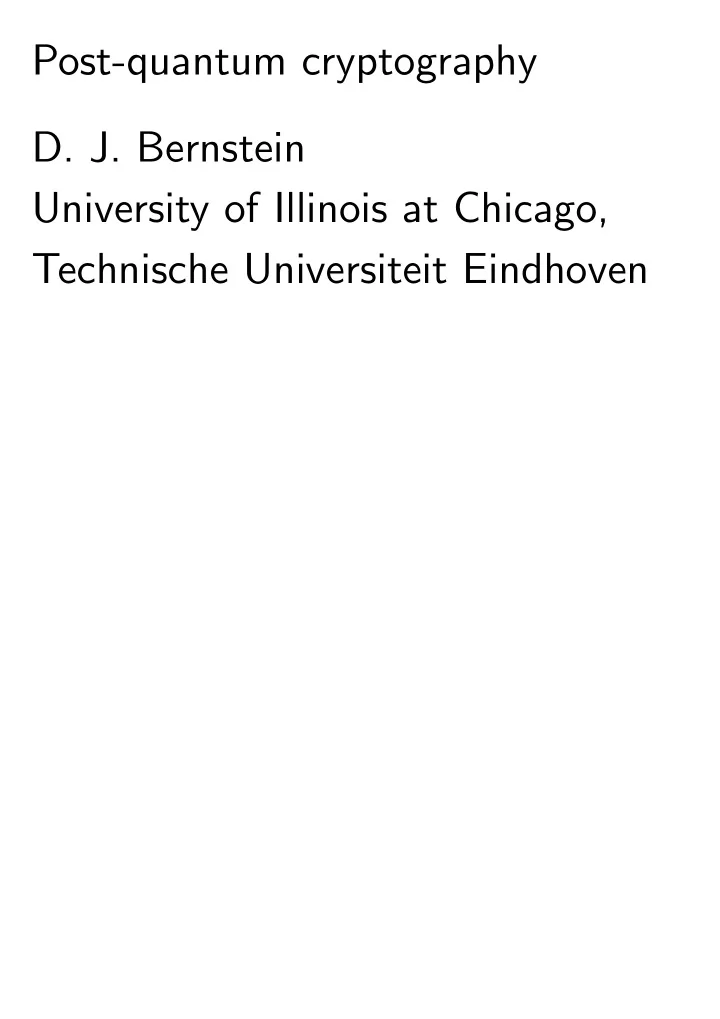

Post-quantum cryptography D. J. Bernstein University of Illinois at Chicago, Technische Universiteit Eindhoven
� � � Cryptographers Working systems Cryptanalytic algorithm designers Unbroken systems Cryptographic algorithm designers and implementors Efficient systems Cryptographic users
1. Working systems Fundamental question for cryptographers: How can we encrypt, decrypt, sign, verify, etc.? Many answers: DES, Triple DES, FEAL-4, AES, RSA, McEliece encryption, Merkle hash-tree signatures, Merkle–Hellman knapsack encryption, Buchmann–Williams class-group encryption, ECDSA, HFE v � , NTRU, et al.
Detailed example (not a very good cryptosystem!): textbook exponent-3 RSA-1024. Receiver’s secret key: distinct 512-bit primes ♣❀ q ✷ 2 + 3 Z . Receiver’s public key: ♣q . Sender’s plaintext: ♠ ✷ ❢ 0 ❀ 1 ❀ ✿ ✿ ✿ ❀ ♣q � 1 ❣ . Sender’s ciphertext: ♠ 3 mod ♣q . Receiver uses ♣❀ q to compute ♠ given ♠ 3 mod ♣q .
2. Unbroken systems Fundamental question for pre-quantum cryptanalysts: What can an attacker do using ❁ 2 ❜ operations on a classical computer? Fundamental question for post-quantum cryptanalysts: What can an attacker do using ❁ 2 ❜ operations on a quantum computer? Goal: identify systems that are not breakable in ❁ 2 ❜ operations.
Examples of RSA cryptanalysis: Schroeppel’s “linear sieve”, mentioned in 1978 RSA paper, factors ♣q into ♣❀ q using (2 + ♦ (1)) (lg ♣q ) 1 ❂ 2 (lg lg ♣q ) 1 ❂ 2 simple operations (conjecturally). To push this beyond 2 ❜ , must choose ♣q to have at least (0 ✿ 5 + ♦ (1)) ❜ 2 ❂ lg ❜ bits. Note 1: lg = log 2 . Note 2: ♦ (1) says nothing about, e.g., ❜ = 128.
1993 Buhler–Lenstra–Pomerance, generalizing 1988 Pollard “number-field sieve”, factors ♣q into ♣❀ q using (3 ✿ 79 ✿ ✿ ✿ + ♦ (1)) (lg ♣q ) 1 ❂ 3 (lg lg ♣q ) 2 ❂ 3 simple operations (conjecturally). To push this beyond 2 ❜ , must choose ♣q to have at least (0 ✿ 015 ✿ ✿ ✿ + ♦ (1)) ❜ 3 ❂ (lg ❜ ) 2 bits. Subsequent improvements: 3 ✿ 73 ✿ ✿ ✿ ; details of ♦ (1). But can reasonably conjecture that 2 (lg ♣q ) 1 ❂ 3+ ♦ (1) is optimal —for classical computers.
Many “protocol” attacks. e.g. attacker guesses user’s ♠ , verifies ♠ 3 mod ♣q . e.g. attacker hopes ♠ ❁ ( ♣q ) 1 ❂ 3 . e.g. attacker sees how receiver reacts to 8 ♠ 3 mod ♣q . Typical fix: feed ♠ through randomization+padding+“AONT”. “Simple RSA” (2001 Shoup): send r 3 mod ♣q for random r ; use hash of r as AES-GCM key to encrypt and authenticate ♠ .
Cryptographic systems surviving pre-quantum cryptanalysis: Triple DES (for ❜ ✔ 112), AES-256 (for ❜ ✔ 256), RSA with ❜ 3+ ♦ (1) -bit modulus, McEliece with code length ❜ 1+ ♦ (1) , Merkle signatures with “strong” ❜ 1+ ♦ (1) -bit hash, BW with “strong” ❜ 2+ ♦ (1) - bit discriminant, ECDSA with “strong” ❜ 1+ ♦ (1) -bit curve, HFE v � with ❜ 1+ ♦ (1) polynomials, NTRU with ❜ 1+ ♦ (1) bits, et al.
Typical algorithmic tools for pre-quantum cryptanalysts: NFS, ✚ , ISD, LLL, F4, XL, et al. Post-quantum cryptanalysts have all the same tools plus quantum algorithms. Spectacular example: 1994 Shor factors ♣q into ♣❀ q using (lg ♣q ) 2+ ♦ (1) simple quantum operations. To push this beyond 2 ❜ , must choose ♣q to have at least 2 (0 ✿ 5+ ♦ (1)) ❜ bits. Yikes.
Cryptographic systems surviving post-quantum cryptanalysis: AES-256 (for ❜ ✔ 128), McEliece code-based encryption with code length ❜ 1+ ♦ (1) , Merkle hash-based signatures with “strong” ❜ 1+ ♦ (1) -bit hash, HFE v � MQ signatures with ❜ 1+ ♦ (1) polynomials, NTRU lattice-based encryption with ❜ 1+ ♦ (1) bits, et al.
3. Efficient systems Fundamental question for designers and implementors of cryptographic algorithms: Exactly how efficient are the unbroken cryptosystems? Many goals: minimize encryption time, size, decryption time, etc. Pre-quantum example: ECDSA with “strong” ❜ 1+ ♦ (1) -bit curve verifies signature in ❜ 2+ ♦ (1) simple operations. Signature occupies ❜ 1+ ♦ (1) bits.
Users have cost constraints. Cryptographers, cryptanalysts, implementors, etc. tend to focus on RSA and ECC, citing these cost constraints. But we think that the most efficient unbroken post-quantum systems will be hash-based systems, code-based systems, lattice-based systems, multivariate-quadratic systems.
Recommend
More recommend